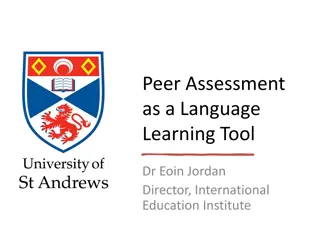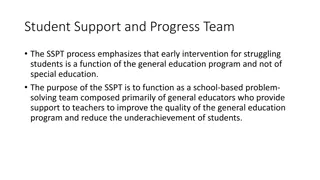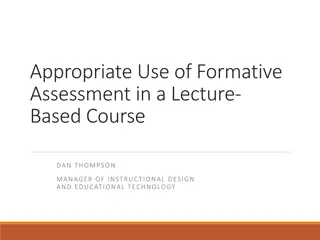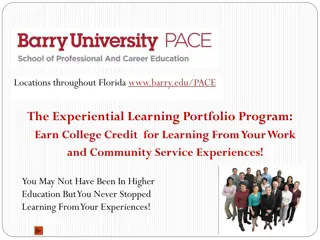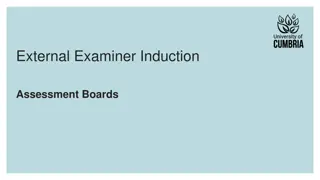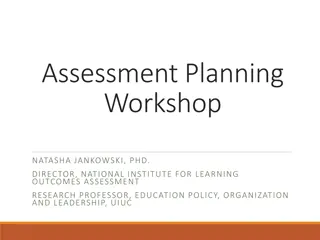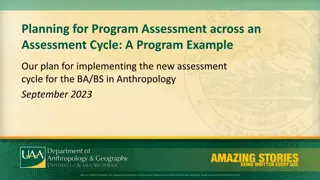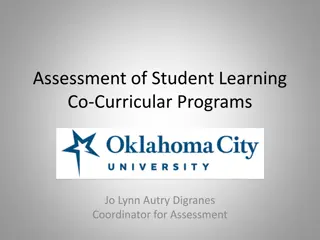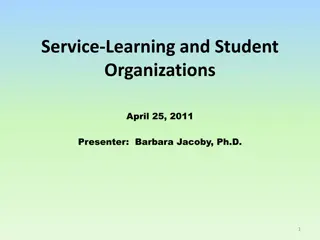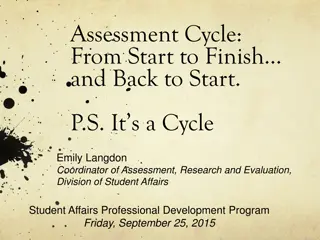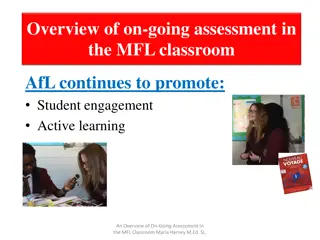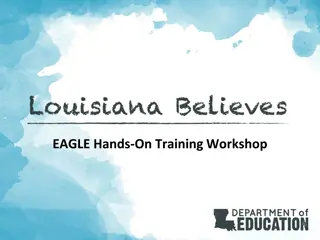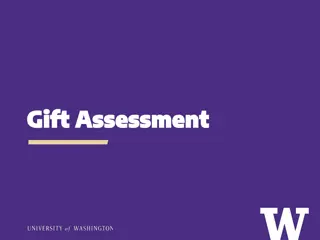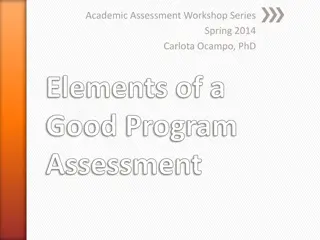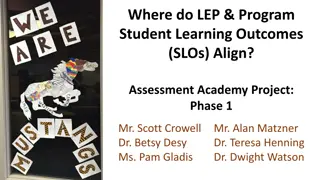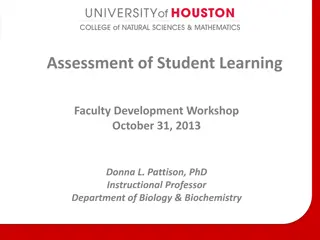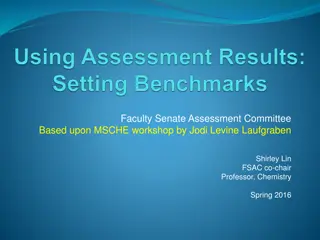University-wide Student Learning Assessment Program Overview
The Assessment & Outcomes Committee is responsible for monitoring the development, evaluation, and reporting of a university-wide process to assess student learning in undergraduate and graduate programs. The program aims to enhance assessment practices, facilitate programmatic improvements, and provide data-driven insights for decision-making. Membership details, the importance of assessment, information utilization, and workshop topics are highlighted in the provided materials.
- Student learning assessment
- Program improvement
- Data-driven decision making
- Assessment committee
- Curriculum mapping
Download Presentation

Please find below an Image/Link to download the presentation.
The content on the website is provided AS IS for your information and personal use only. It may not be sold, licensed, or shared on other websites without obtaining consent from the author. Download presentation by click this link. If you encounter any issues during the download, it is possible that the publisher has removed the file from their server.
E N D
Presentation Transcript
ASSESSMENT & OUTCOMES COMMITTEE CHARGE: Monitor the development, evaluation, and reporting of a university-wide process to assess student learning in undergraduate and graduate degree programs through departmental collaboration, resulting in meaningful assessment and programmatic improvements. https://www.montana.edu/provost/assessment/program_assessment.html https://www.montana.edu/provost/assessment/program_assessment.html
2018-19 MEMBERSHIP NAME POSITION REPRESENTS Anderson, Rachel Chair Academic Affairs Dougher, Tracy Administration Agriculture Adams, Dean Administration Arts & Architecture Leary, Myleen Administration Business Harmon, Alison Administration Education & HHD Amin, Ruhul Faculty Engineering Maki, Sarah Administration Gallatin College Larsen, Ron Administration Graduate School Schultz, Logan Administration Honors College Thorsen, Maggie Faculty Letters & Science Eitle, David Administration Letters & Science Peters, Martha Faculty Nursing Godwin, Ian Administration Planning & Analysis
WHY ASSESS? DOCUMENT PROGRAM EFFECTIVENESS IDENTIFY AREAS FOR IMPROVEMENT Keeping curriculum current and relevant PROVIDE INFORMATION FOR DATA DRIVEN DECISION MAKING REQUIRED FOR ACCREDITATION!
WHAT HAPPENS TO THE INFORMATION? PROGRAM ASSESSMENT REPORTS ARE SENT TO: Department Heads Deans Provost INFORMATION CAN BE USED TO: Redesign programs/curriculum updates Funding Allocations Other .
https://www.montana.edu/provost/assessment/program_assessment_overview.htmlhttps://www.montana.edu/provost/assessment/program_assessment_overview.html
AT TODAYS WORKSHOP Program Learning Outcomes (PLOs) & Curriculum Mapping Assessment Planning Chart Development of Threshold Values Assessment Rubrics
PROGRAM LEARNING OUTCOMES PLOs identify what students will know/or be able to do by the end of a program Framed as statements that describe essential learning that students can demonstrate Should represent your highest aspirations for your students Framed in terms of the program (not specific classes no one individual course should have every expected outcome) Outcomes are based in concrete actions verbs
WHERE ARE YOUR OUTCOMES? Ideally they are on your program website! http://animalrange.montana.edu/program_assessment.html We also want them in CiM!!!! http://www.montana.edu/registrar/CourseleafHelp.html
LETS START WITH PLOs CHECK LIST 1)Are outcomes aligned with the program s mission? 2)Are they clearly measureable? 3)Are outcomes expressed in a way that focuses on what students will be able to demonstrate?
EXAMPLE: ENVIRONMENTAL SCIENCE 1. An understanding of core theoretical principles and applications in evolutionary, ecological and physical environmental sciences. 2. Ability to access, read, and critically assess the quality and source of environmental information. 3. Knowledge of the theory and practice of data analysis in environmental sciences, including statistical analysis, model building, and graphical presentation of data. 4. The ability to write and present scientific material effectively. 5. An understanding of the ethical implications of conducting and applying environmental science.
EXAMPLE: MATHEMATICS Math update has now included all options for a common assessment: Students will demonstrate mathematical reasoning or statistical thinking. Students will demonstrate effective mathematical or statistical communication. Students will develop mathematical or statistical independence in proving, problem solving, and modeling.
SOME OTHER EXAMPLES: BOSTON UNIVERSITY: Learning Outcomes by Program Good rule of thumb No more than 5 outcomes are ideal.
COMPARE NOTES: 10 MINUTES Take turns explaining your PLOs with other members of your table do they meet the requirements of the check-off list? What are some of the areas of concern? How many outcomes do you have, can that total number be reduced with out compromising your objectives?
CURRICULUM MAPPING What is Curriculum Mapping? Curriculum mapping is the process of matching learning outcomes with elements of the curriculum to create an alignment between goals and learning opportunities For the purposes of assessing program learning outcomes, curriculum mapping visually represents key elements of a program and how they contribute to student learning
WHY DO IT? Curriculum mapping makes it possible to identify where in the program learning objectives are addressed Use it to create, verify, or clarify an alignment between what students do in their courses or co-curricular experiences and what faculty expect them to learn. Helps identify gaps as well as opportunities for assessment
LETS MAP: 1) Identify selected courses required for program (you may want to consider expectation levels Introductory, Developing, or Mastery ) 2) Review course learning outcomes (a course does not need to meet every outcome choose the ones that are the most applied to the curriculum) 3) Match courses with Program Learning Outcomes.
PLOs for Microbiology/Immunology 1. Use knowledge of the fundamental terms and concepts of microbiology 2. Design an experiment to test a hypothesis or microbiological concept 3. Perform basic microbiological lab techniques 4. Access and analyze bioinformatic data or large datasets 5. Verbally communicate about fundamental and modern microbiological concepts 6. Communicate in written form about fundamental and modern microbiological concepts
Example: Microbiology/immunology Outcomes 3 1 2 4 5 6 BIOM 360 General Microbiology BIOM 455 Research Methods in Microbiology BIOM 441 Eukaryotic Pathogens BIOM 432 Medical Bacteriology Lab BIOM 450 Microbial Physiology BIOM 494 Senior Seminar BIOH 405 Hematology (lecture) BIOB 410 Immunology BIOM 435 - Virology X X X X X X X X X X X
PLOs FOR ANIMAL SCIENCE 1. design and evaluate animal management systems by synthesizing and applying knowledge of biological processes related to animals and the rangeland plants that support them. [knowledge] 2. identify and critically evaluate scientific or technical animal science content to make informed decisions providing a foundation for lifelong learning. [critical thinking] 3. demonstrate effective oral and written communication to a range of audiences and within collaborative environments. [communication and collaboration] 4. use scientific principles to formulate questions, explore solutions, and solve real-world problems and advocate based on science. [problem solving] 5. be able to actively engage in discussions of complex ethical issues in their profession. [ethics]
EXAMPLE: Animal science includes course level expectations: Outcomes ANSC 316 Meat Science ANSC 416R Meat Processing (presentation) ANSC 432R Sheep Management ANSC 434 R Beef Cattle Management ANSC 418 Topics in Beef Cattle Nutrition Or EQUS 423 Equine Nutrition ANSC 421 Assisted Reproductive Techniques BIOM 405 Host-Associated Microbial Ecology 1 2 3 4 5 M M D D M M D M M D D D D D D D M D D
EARLY CHILDHOOD EDUCATION & CHILD SERVICES Combination of mapped curriculum and identification of assessment items (data)
QUESTIONS? Based on your course learning outcomes which courses best exemplify the PLO s? Are all PLO s covered? Are there any outliers? Courses that either don t map to the PLO s, or: PLO that is not represented in the curriculum.
Assessment Planning Chart ASSESSMENT PLANS SHOULD REFLECT MULTIPLE YEARS SHOULD INCLUDE A CLOSING THE LOOP CYCLE ARE NOT WRITTEN IN STONE
EXAMPLE: PHOTONICS AND LASER TECHNOLOGY Note: every two years the program has the opportunity to assess how program changes or improvements have made positive impacts on student learning and success.
PUTTING IT ALL TOGETHER: SOCIOLOGY In this table you have all the elements together: PLOs Course identification Review cycle Assignment (assessment) activities (data)
Development of Threshold Values DEFINITION: AN ESTABLISHED CRITERIA FOR WHICH OUTCOME ACHIEVEMENT IS DEFINED AS MET OR NOT MET.
EXAMPLE: DOCTORAL PROGRAM IN MATERIAL SCIENCE
Assessment Rubrics What s being assessed and how does data reflect the outcomes? What course activities, projects, exam questions, etc., best define the learning outcome (s)? How will that be measured?
EXAMPLE: BUSINESS PLO: Effective Written Communication: Courses Identified: BMGT 205 & BMGT 366 Course assignment identified (agreed by program faculty) Students writing skills were rated as unacceptable, satisfactory or outstanding on each of four measures: organization/development of ideas spelling and punctuation grammar and sentence structure overall


